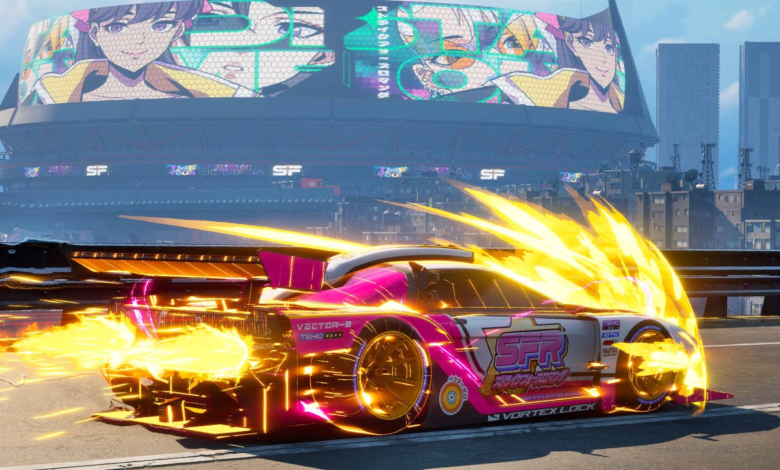
Much like all-you-can-eat Pizza Huts, reasonably-priced concert tickets, and The Secret World of Alex Mack, Screamer is something I enjoyed in the 1990s but essentially disappeared from our lives decades ago. The original Screamer, released in 1995, was one of a trio of games developed by Italian studio Graffiti before it quickly rebranded itself as Milestone a year later. An over-the-top arcade racing game exclusively for PC, it arrived rapidly in the slipstream of pioneering 3D racers like The Need for Speed, Ridge Racer, and Destruction Derby (and was followed by a sequel and two one-and-done spin-offs) but has faded into relative obscurity since. However, over a quarter of a century since Milestone’s final Screamer game, the series is howling back to the track with a wild new look and an interestingly nuanced suite of controls and power-ups that shake up the slamming, the shifting, and even the steering.
According to game director Federico Cardini, Screamer is a game Milestone has long wanted to resurrect, but you should know that it’s more the name that’s being brought back here. That is, aside from the title there really isn’t anything immediately significant in the new Screamer that meaningfully reminds me of the original. Dramatic changes of identity are usually kryptonite for sequels and reboots – especially belated ones – but I actually don’t think it’s a problem in Screamer’s case. The original was an impressive game for its time, but it was admittedly otherwise largely typical of arcade racing games in that era. The new one is a bit of a different story.
You can’t describe Screamer in a single sentence the way you can with a lot of arcade racing games. A good deal of arcade racers generally allow you to count the number of pertinent instructions on your nipples. That is, there are only two: accelerate and steer. After an hour of hands-on driving and drifting with Screamer it’s clear there’s a lot more to it than this, and it’s this depth that makes it quite fascinating.
Screamer is a twin-stick racing game, and it instantly reminds me of 2020’s Inertial Drift in this sense. While the left stick is used for conventional steering, the right stick is used to add drift angle. In simple terms, the left stick controls the front of the car, and the right stick basically controls the rear. It’s easier to grasp than it perhaps sounds, but it does require a certain deftness on both sticks to make the necessary adjustments to your angle.
It goes much further than this, however, as Screamer also packs a potent range of power-ups that are extracted from two separate gauges that fill based on certain actions. Inspired by fighting games, Screamer calls this its ‘Echo’ system – where using one side of the gauge affects the other side. There’s a shotgun spray of bespoke, in-game terminology that you’ll encounter if and when you play Screamer yourself, but I’m going to avoid most of that here because I think it’ll only serve to make Screamer sound a little impenetrable. On track – and in the thick of it – it’s all fairly intuitive, so I’ll try to describe it as such.
Essentially, the left side of the gauge will fill throughout a race both passively and via certain actions – like perfectly-timed shifts. Screamer’s vehicles have semi-automatic transmissions, so they’ll shift automatically if you’re overwhelmed (or you forget), but if you nail your upshifts you’ll fill the left gauge faster. It’s not a remotely racing related comparison, but it reminded me of Gears of War’s active reload system.
The left gauge is used to provide both boosts and shields against attacking opponents. Even boosts are handled differently, with a press–hold-and-release mechanic that you need to time by using an onscreen icon. Get the release spot-on and you will earn a longer and more effective boost than standard.
So what of the gauge on the right? Well, you fill the gauge on the right by using the power-ups afforded by the gauge on the left. The gauge on the right allows you to use the offensive abilities Screamer has dubbed ‘strike’ and ‘overdrive.’ ‘Strike’ is a temporary boost in speed during which any other car you smash into will explode, and ‘Overdrive’ is an indefinite boost that lasts until you crash. Overdrive is pretty tough to use on the twistiest portions of the tracks; after a certain amount of time locked in Overdrive you’ll reach a critical state where even a brush off a wall will see you blow up. It is extremely quick, though, and it’s a power-up I observed the AI was always willing to deploy at every opportunity.
Like the 1995 original, Screamer features a roster of unlicensed cars. However, while the original game’s cars were clearly just de-badged versions of iconic ’90s sports cars and exotics with otherwise generic names, the cars in the upcoming Screamer are wild, anime-inspired vehicles covered in aggressive, time attack-style aero. The anime inspiration extends beyond the cars, too; indeed, Milestone has partnered with Japanese animation studio Polygon Pictures for Screamer’s story. We weren’t privy to any of these cutscenes during our preview, but I did get to race as a variety of different characters – each of whom have different abilities that alter how they fill their power gauge, and how their cars handle. There’s a really significant difference in car feel across characters so, even though the handling is quite easy to pick up, it’s not one-note.
Milestone achieved the improbable in 2021 with Hot Wheels Unleashed, creating a gorgeous and highly approachable arcade racing banger that far exceeded any expectations one might have had of a game based on a licensed toy. It’s a very different sort of racing experience to the Hot Wheels Unleashed series but, after my hour with it, I’m not expecting Screamer to quietly come and go when it arrives in 2026.
Luke is a Senior Editor on the IGN reviews team. You can track him down on Bluesky @mrlukereilly to ask him things about stuff.
Source link




